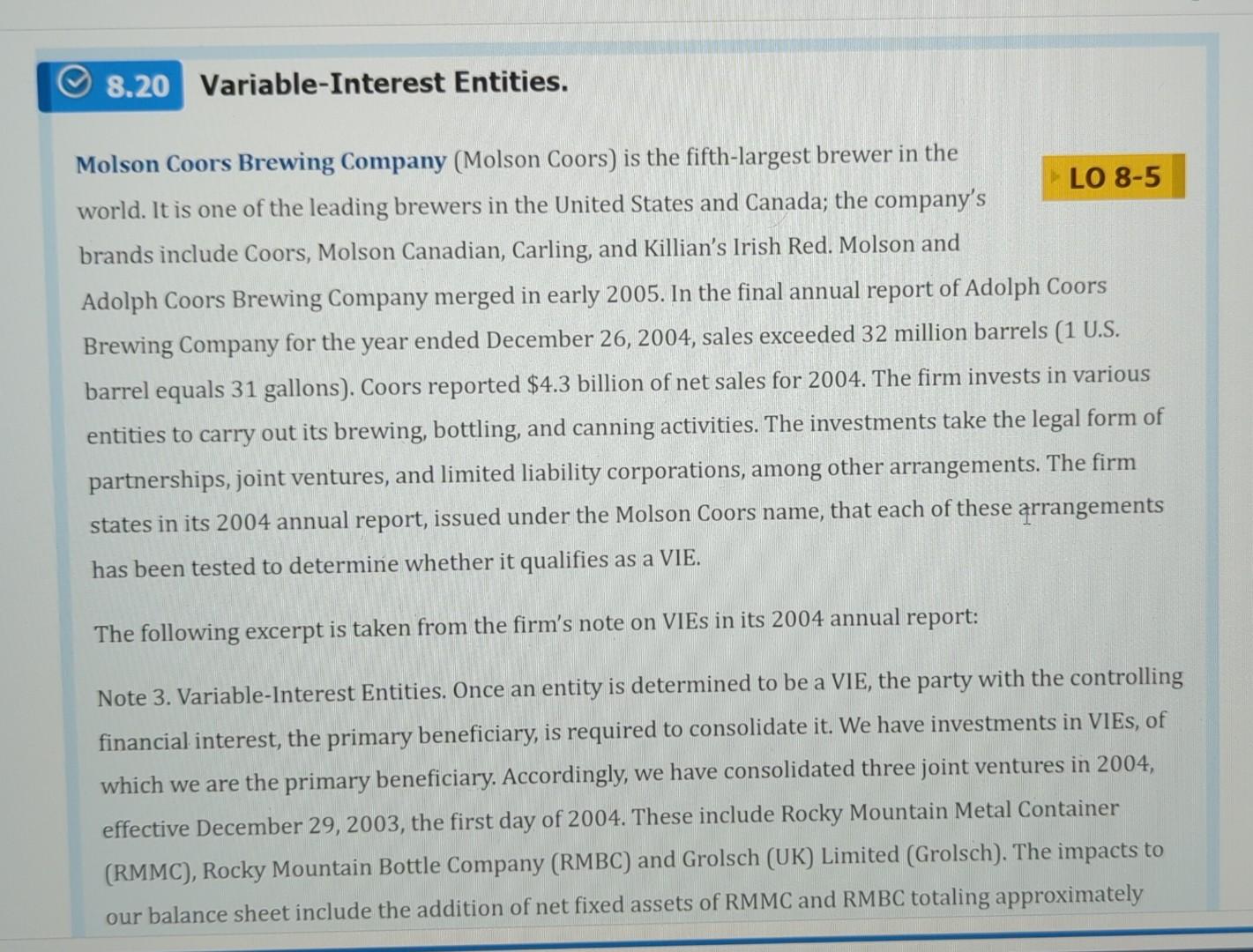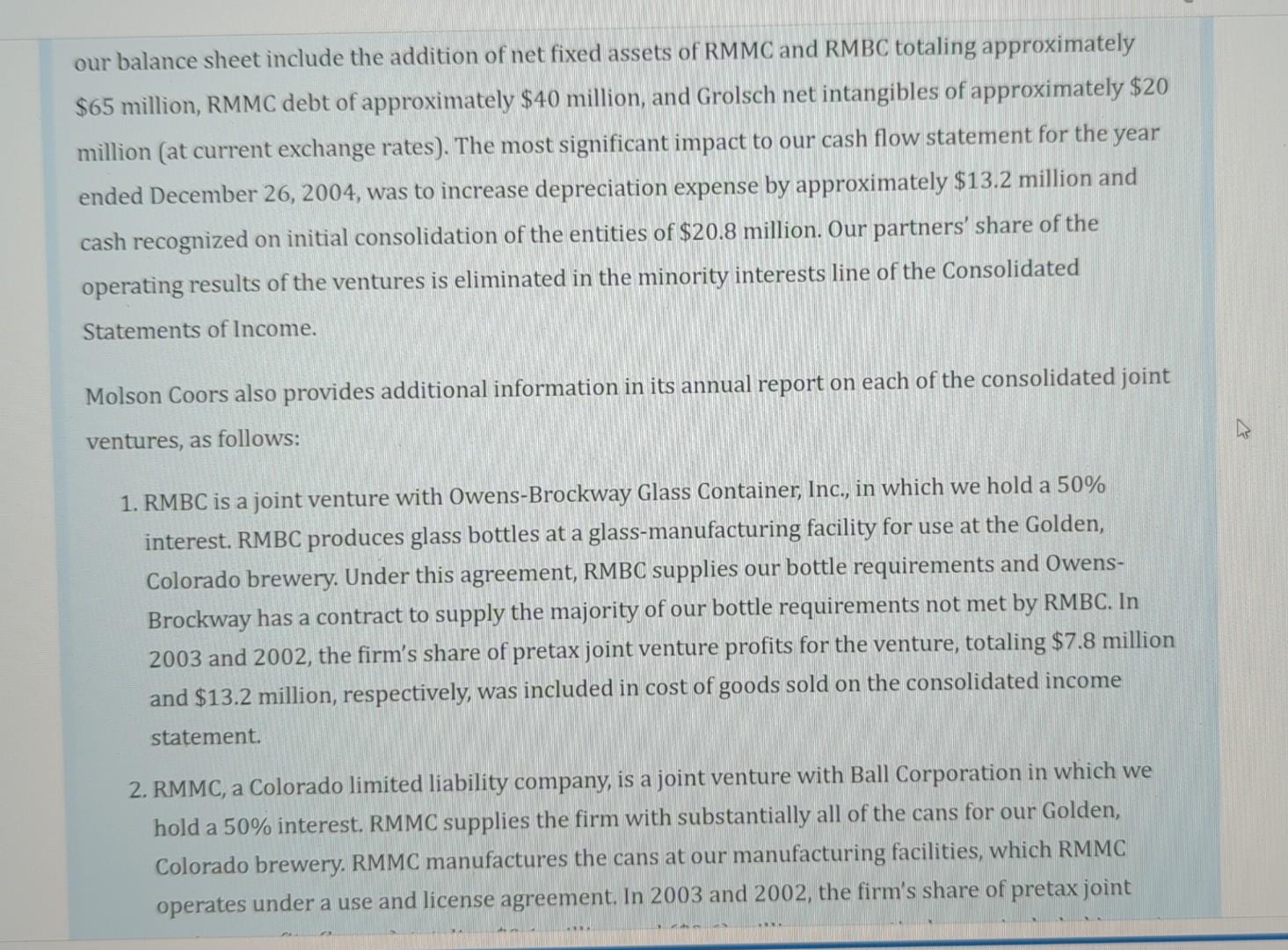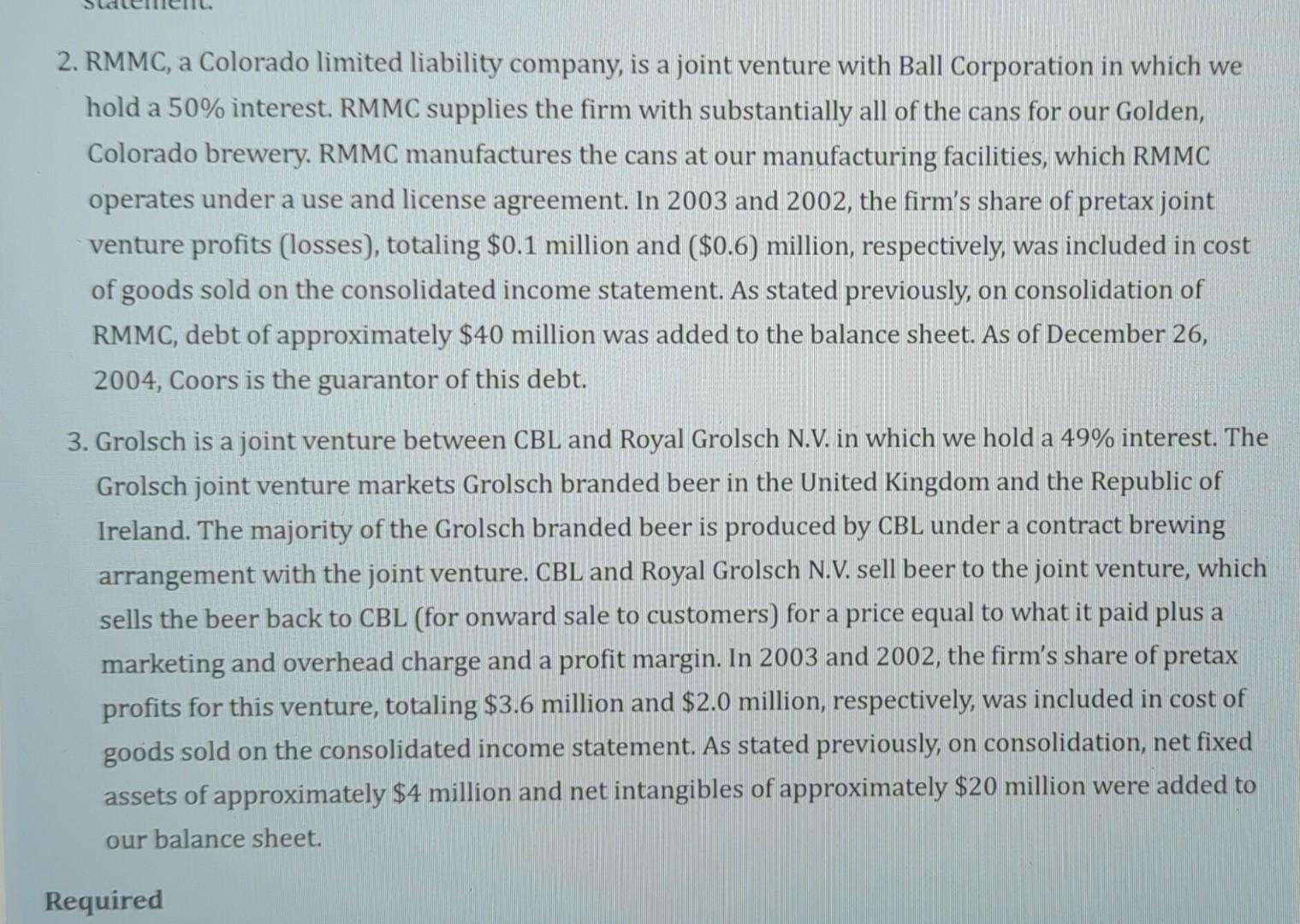Answered step by step
Verified Expert Solution
Question
1 Approved Answer
please answer a-f, thank you! Molson Coors Brewing Company (Molson Coors) is the fifth-largest brewer in the world. It is one of the leading brewers




please answer a-f, thank you!
Molson Coors Brewing Company (Molson Coors) is the fifth-largest brewer in the world. It is one of the leading brewers in the United States and Canada; the company's brands include Coors, Molson Canadian, Carling, and Killian's Irish Red. Molson and Adolph Coors Brewing Company merged in early 2005. In the final annual report of Adolph Coors Brewing Company for the year ended December 26, 2004, sales exceeded 32 million barrels (1 U.S. barrel equals 31 gallons). Coors reported $4.3 billion of net sales for 2004 . The firm invests in various entities to carry out its brewing, bottling, and canning activities. The investments take the legal form of partnerships, joint ventures, and limited liability corporations, among other arrangements. The firm states in its 2004 annual report, issued under the Molson Coors name, that each of these arrangements has been tested to determine whether it qualifies as a VIE. The following excerpt is taken from the firm's note on VIEs in its 2004 annual report: Note 3. Variable-Interest Entities. Once an entity is determined to be a VIE, the party with the controlling financial interest, the primary beneficiary, is required to consolidate it. We have investments in VIEs, of which we are the primary beneficiary. Accordingly, we have consolidated three joint ventures in 2004, effective December 29, 2003, the first day of 2004. These include Rocky Mountain Metal Container (RMMC), Rocky Mountain Bottle Company (RMBC) and Grolsch (UK) Limited (Grolsch). The impacts to our balance sheet include the addition of net fixed assets of RMMC and RMBC totaling approximately our balance sheet include the addition of net fixed assets of RMMC and RMBC totaling approximately $65 million, RMMC debt of approximately $40 million, and Grolsch net intangibles of approximately $20 million (at current exchange rates). The most significant impact to our cash flow statement for the year ended December 26,2004 , was to increase depreciation expense by approximately $13.2 million and cash recognized on initial consolidation of the entities of $20.8 million. Our partners' share of the operating results of the ventures is eliminated in the minority interests line of the Consolidated Statements of Income. Molson Coors also provides additional information in its annual report on each of the consolidated joint ventures, as follows: 1. RMBC is a joint venture with Owens-Brockway Glass Container, Inc., in which we hold a 50% interest. RMBC produces glass bottles at a glass-manufacturing facility for use at the Golden, Colorado brewery. Under this agreement, RMBC supplies our bottle requirements and OwensBrockway has a contract to supply the majority of our bottle requirements not met by RMBC. In 2003 and 2002, the firm's share of pretax joint venture profits for the venture, totaling $7.8 million and $13.2 million, respectively, was included in cost of goods sold on the consolidated income statement. 2. RMMC, a Colorado limited liability company, is a joint venture with Ball Corporation in which we hold a 50% interest. RMMC supplies the firm with substantially all of the cans for our Golden, Colorado brewery. RMMC manufactures the cans at our manufacturing facilities, which RMMC operates under a use and license agreement. In 2003 and 2002, the firm's share of pretax joint 2. RMMC, a Colorado limited liability company, is a joint venture with Ball Corporation in which we hold a 50% interest. RMMC supplies the firm with substantially all of the cans for our Golden, Colorado brewery. RMMC manufactures the cans at our manufacturing facilities, which RMMC operates under a use and license agreement. In 2003 and 2002, the firm's share of pretax joint venture profits (losses), totaling $0.1 million and ( $0.6) million, respectively, was included in cost of goods sold on the consolidated income statement. As stated previously, on consolidation of RMMC, debt of approximately $40 million was added to the balance sheet. As of December 26 , 2004 , Coors is the guarantor of this debt. 3. Grolsch is a joint venture between CBL and Royal Grolsch N.V. in which we hold a 49% interest. The Grolsch joint venture markets Grolsch branded beer in the United Kingdom and the Republic of Ireland. The majority of the Grolsch branded beer is produced by CBL under a contract brewing arrangement with the joint venture. CBL and Royal Grolsch N.V. sell beer to the joint venture, which sells the beer back to CBL (for onward sale to customers) for a price equal to what it paid plus a marketing and overhead charge and a profit margin. In 2003 and 2002, the firm's share of pretax profits for this venture, totaling $3.6 million and $2.0 million, respectively, was included in cost of goods sold on the consolidated income statement. As stated previously, on consolidation, net fixed assets of approximately $4 million and net intangibles of approximately $20 million were added to our balance sheet. a. Describe the operational purpose of the three VIEs consolidated by Molson Coors. b. Molson Coors is the primary beneficiary for three investments that the firm identified as VIEs. What criteria did Molson Coors apply to determine that the firm is the primary beneficiary for these three investments? c. For each investment, Molson Coors reports the income statement impact as a reduction of cost of goods sold on the consolidated income statement. What is the rationale for reporting the impact this way on the income statement? d. The firm states, "Our partners share of the operating results of the ventures is eliminated in the minority interests line of the Consolidated Statements of Income." Define minority interests as it appears on the income statement. Discuss why Molson Coors subtracts it to calculate consolidated net income. e. RMBC, RMMC, and Grolsch are consolidated with the financial statements of Molson Coors because the three investments qualify as VIEs as defined in Interpretation No. 46 and the firm determined that it is the primary beneficiary for the investments. Explain what reporting technique Molson Coors would use to account for the investments if, in fact, they did not qualify as VIEs. What would be the impact on the balance sheet? What would be the impact on the income statement? What would be the impact on the statement of cash flows? f. The firm reports that the depreciation expense on the statement of cash flows for 2004 increased by approximately $13.2 million as a result of consolidating the VIEs. Why did consolidating the VIEs increase depreciation expenseStep by Step Solution
There are 3 Steps involved in it
Step: 1

Get Instant Access to Expert-Tailored Solutions
See step-by-step solutions with expert insights and AI powered tools for academic success
Step: 2

Step: 3

Ace Your Homework with AI
Get the answers you need in no time with our AI-driven, step-by-step assistance
Get Started


